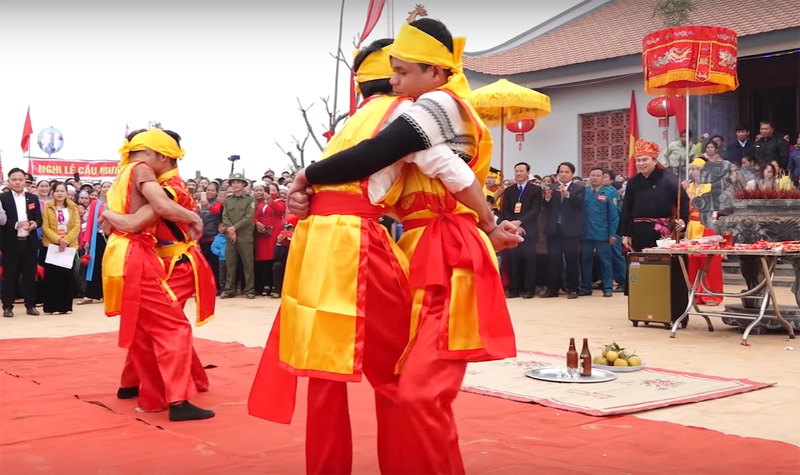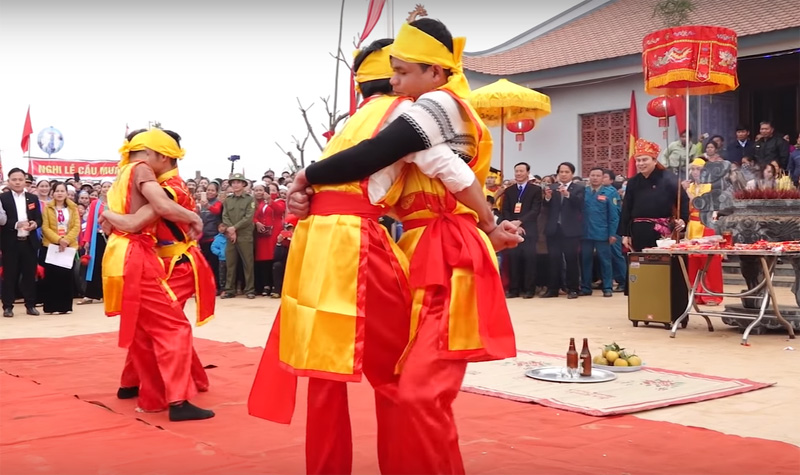
(HBO) - Muong ethnic group’s traditional wrestling is both an unique traditional folk game and a sport for youths. Every New Year when spring comes, Muong traditional wrestling is revived at festivals, apart from fun sports such as crossbow shooting, tug of war, stick pushing and volleyball.
 Muong traditional
wrestling at 2020 Khoi communal house festival in An Nghia commune, Lac Son
district.
Muong traditional
wrestling at 2020 Khoi communal house festival in An Nghia commune, Lac Son
district.
Muong traditional wrestling has existed for
thousands years. In the past, locals competed in wrestling matches, not only
during spring festivals. During the opening of the 2020 Khoi communal house
festival in An Nghia commune, Lac Son dsitrict, the revival of Muong
traditional wrestling was welcomed by the public.
Meritorious Artisan Bui Huy Vong from Huong
Nhuong commune, Lac Son district said traditional wrestling was an official
sport at the district sports festival in 2017. It is not only a folk game but
also a religious ritual during festivals. The game is quite simple, only
requiring a few movements to play. But to play well, experience and techniques
are needed to win rivals. Also according to him, the game is the most popular
in former Lien Vu commune (now Vu Ban township).
In Muong Khenh area, Van Son commune, Lac Son
district, a temple (now already demolished) was dedicated to Chuong Tin and
Trieu An (legend has it that they were generals of Trieu Thi Trinh) – who led
the people against the Wu enemy. According to the legend, apart from training
soldiers in crossbow shooting, they also included Muong wrestling into a
compulsory training session each day for soldiers. Every three years, on the
full moon day of the second lunar month, the Muong people hold a big festival.
Traditional wrestling and crossbow shooting have become religious rituals to
remember Chuong Tin and Trieu An who trained soldiers in the past.
This game is usually held on flat grounds or
clean sandy beaches, without any sticks or gravels to ensure the safety of
wrestlers. Only two opponents join each round. When entering the match, both
must absolutely obey the referee's instructions. The winner will be promoted to
the next round, while the loser will be out of the game.
Muong traditional wrestling is quite diverse in
style and trick, but there are some basic steps such as preparation, also known
as "catching" (hugging), during which the two wrestlers step to face,
with straight back and chest rubbing close together, and then hand out hugging
behind the opponents’ belts on the principle of inside and outside hands. This
step requires straight back naturally, feet placed in parallel with the
opponent's on the principle inside and outside legs. When the two sides do not
break the rules of catching, the referee will order them to compete.Whoever
falls to the ground or is dropped to the ground is defeated. The rules seem to
be simple, but the way to play the game makes it hard for the opponent to use
bad tricks or fraud.
Nowadays, many modern sports have gradually
replaced Muong traditional wrestling. In the coming time, the provincial
Culture, Sports and Tourism Department is expected to pay more attention to
preserving and upholding traditional cultural values of the nation, including
Muong traditional wrestling./.
Hoa Binh province has carried out multiple programmes and initiatives to revive its cultural heritage which has gradually fallen into oblivion through the ebbs and flows of history.
The most prominent and defining feature in the prehistoric era of Hoa Binh is the Hoa Binh Culture. The Culture was first discovered in Hoa Binh. The significant prehistoric culture represents not only Vietnam but also Southeast Asia and southern China. Through excavations of cave sites in the limestone regions of Hoa Binh, French archaeologist M. Colani introduced the world to a "Stone Age in Hoa Binh province – Northern Vietnam" in 1927. On January 30, 1932, the First Congress of Far Eastern Prehistorians, held in Hanoi, officially recognised the Hoa Binh Culture.
Known as the "Land of Epic History”, Hoa Binh province, the gateway to Vietnam’s northwest, boasts a strategic location and a unique cultural tapestry woven by its ethnic minority communities.
The People's Committee of Luong Son District recently held a ceremony to receive the certificate recognizing Sau Communal House in Thanh Cao Commune as a provincial-level historical and cultural site.
Recognising the importance of cultural heritage preservation in protecting and promoting the value system of Vietnamese culture, and serving socio-economic development in the new period, Party committees and local administrations in Hoa Binh province have identified it as a key task in the cultural development strategy. The province has been making efforts in mobilising resources, creating consensus among people and engaging ethnic communities in preserving and promoting cultural identity.
Hoa Binh province has captured growing attention both domestically and internationally for its distinctive cultural heritage and rich history. Most notably, it has been renowned for its famous Hoa Binh culture, considered the cradle of ancient Vietnamese civilisation. Looking ahead to significant milestones in 2025 and the 140th anniversary of province establishment in 2026, Hoa Binh Newspaper presents a comprehensive overview of the province's development across economic, social, cultural, tourism, and security domains.



 Muong traditional
wrestling at 2020 Khoi communal house festival in An Nghia commune, Lac Son
district.
Muong traditional
wrestling at 2020 Khoi communal house festival in An Nghia commune, Lac Son
district.